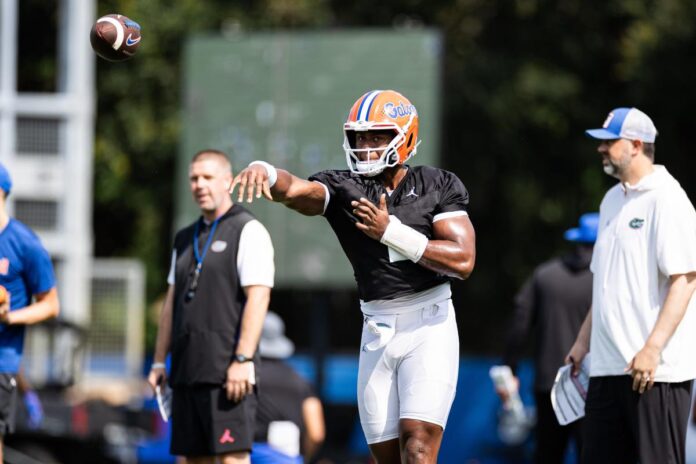Count Florida football coach Billy Napier as a fan of the new FBS rule allowing in-helmet communication beginning this season.
Napier has tested the technology throughout fall camp, including Saturday’s first Florida Gators fall scrimmage.
“It’s going pretty well,” Napier said. “We’ve worked at it quite a bit. I think we’ve done a ton of research. It’s definitely a game-changer. It’s going to change college football for sure.”
The rule allows for one player on each side of the ball to have a radio inside his helmet. Communication will be shut off with 15 seconds before the end of the 40-second play clock, or when the ball is snapped, whichever comes first.
“There’s quite a bit of time left when the play (call) is done,” Napier said. “I think it’s a big deal. There’s going to be a ton of strategy around it.
“It’s not just the quarterback. It’s the signal caller on defense, too. I’m listening, ‘OK, play’s in,’ talking to the linebacker. You can set the front. You can set the close call. You can set the pass strength. You can talk alerts, hey, run/pass. And then it turns off on you.”
Napier said he’s seen the communication benefit freshman quarterback D.J. Lagway in his development.
“He’s been playing great,” Napier said. “Trusting it. I think just having that added coaching point when it’s not just you on the line getting to [the] play: OK, what’s my job here? You get the extra coaching point: OK, this is my read. This is my progression. This is my check that we have on a certain play. It’s been great for him.”
Starting Florida quarterback Graham Mertz said it would have been nice to have coming up as a young quarterback. As a redshirt freshman starter for Wisconsin in 2020, Mertz recalled having to memorize a 20-word signal before the start of the play.
“You might still need to have the signals but to bypass that and have the coach in your ear just getting coaching points on certain plays, that can help you play faster, trust your preparation,” Mertz said.
How in-helmet radio rule could determine how much Florida football huddles
The new technology could impact how often Florida huddles during a game. The trend for college football offenses has gone up-tempo and no huddle to maximize the number of plays in four 15-minute quarters.
“You can use it in so many different ways,” Mertz said. “You can slow the game down; you can huddle up. You can speed it up when you need to.
“There’s so many different ways you can utilize it. Of course, that’s been an emphasis for us going into camp, throughout camp, is just pushing our pace. Getting up to the ball and getting set. You know the helmet thing cuts out at 15 seconds. How much information can you get out before that cuts off?”
Former Florida quarterback Shane Matthews said the rule change is long overdue but wonders how effectively it can be utilized in no-huddle offenses. Matthews, now an analyst with the Gator Radio Network, was in his second year as an NFL quarterback when helmet radio technology was first adopted at the pro level in 1994.
“In college, guys never huddle up usually, so the quarterback is the only guy getting the information,” Matthews said. “So, he can tell the running backs and the O-line but the receivers still have to get the signals from the sideline.”
Napier said the new rule will present plenty of strategic options when it comes to tempo.
“You can shrink the game, or you lengthen the amount or shrink the amount of time the opponent has with their signal caller on the defense,” Napier said. “Or you speed it up for you can talk to your guy more. Every coach in America is going through this right now.”
How in-helmet radios will impact Florida football defense
Florida co-defensive coordinator and linebackers coach Ron Roberts said the new rule favors inexperienced quarterbacks, who will now get more guidance from offensive coordinators.
“It’s not a quarterback on the field making the check, it’s the guy in the box,” Roberts said. “So a lot of times we would get down ― previously you would say, hey, I want to, we’re going to stem, move, change the front because I want to play this game vs. a 20-year-old quarterback. I don’t want to play the coordinator. I want to play against him. So, you’ve kind of taken an element of that out.”
But Roberts says there are ways it can benefit the defense,
“It can also help us put a player at ease. It can put ― you know what I mean? Talk to him about what he’s expecting,” Roberts said. “It’s a way to get communication on the field to another position. Say, hey, remind him of this. Think of this. Hey, if they get in this formation, remember this is what we want to be in.”
Roberts said he experimented with both safeties and linebackers wearing the radio helmets during the spring but is trending toward a linebacker during games. Junior UF linebacker Shemar James wore the radio helmet during UF’s first scrimmage Saturday.
“That has allowed us to play a little faster, also get the coaches inside of things, alert motions, pre snap checks, pre snap adjustments,” James said. “It’s also allowed us to communicate a little better with the defense and also the back end.”
This article originally appeared on The Gainesville Sun: How Florida football is adapting to in-helmet radio technology

